MENU
The Electronic Scholarly Publishing Project: Providing access to classic scientific papers and other scholarly materials, since 1993. More About: ESP | OUR CONTENT | THIS WEBSITE | WHAT'S NEW | WHAT'S HOT
Comparative Timelines
The ESP Timeline (one of the site's most popular features) has been completely updated to allow the user to select (using the timeline controls above each column) different topics for the left and right sides of the display.
Select:
New Left Column
New Left Column
Dates
Decade
New Right Column
New Right Column
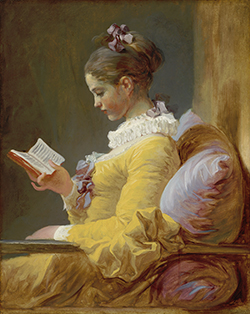 Painting by Jean-Honor Fragonard: Young Girl Reading, or The Reader (French: La Liseuse), is an 18th-century oil painting, purchased by the National Gallery of Art in Washington, DC in 1961 using funds donated by Ailsa Mellon Bruce, the daughter of Andrew W. Mellon, following her father's death. The work is more a genre painting of an everyday scene than a portrait, and the name of the sitter is not known. X-ray photography has revealed that the canvas originally featured a different head looking towards the viewer, which Fragonard painted over.
Painting by Jean-Honor Fragonard: Young Girl Reading, or The Reader (French: La Liseuse), is an 18th-century oil painting, purchased by the National Gallery of Art in Washington, DC in 1961 using funds donated by Ailsa Mellon Bruce, the daughter of Andrew W. Mellon, following her father's death. The work is more a genre painting of an everyday scene than a portrait, and the name of the sitter is not known. X-ray photography has revealed that the canvas originally featured a different head looking towards the viewer, which Fragonard painted over.
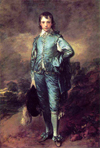 Painting by Thomas Gainsborough: The Blue Boy. Perhaps Gainsborough's most famous work, it is thought to be a portrait of Jonathan Buttall (1752 1805), the son of a wealthy hardware merchant, although this has never been proven. It is a historical costume study as well as a portrait: the youth in his 17th-century apparel is regarded as Gainsborough's homage to Anthony van Dyck, and in particular is very close to Van Dyck's portrait of Charles II as a boy.
Painting by Thomas Gainsborough: The Blue Boy. Perhaps Gainsborough's most famous work, it is thought to be a portrait of Jonathan Buttall (1752 1805), the son of a wealthy hardware merchant, although this has never been proven. It is a historical costume study as well as a portrait: the youth in his 17th-century apparel is regarded as Gainsborough's homage to Anthony van Dyck, and in particular is very close to Van Dyck's portrait of Charles II as a boy.
 Crispus Attucks, an escaped slave, becomes the first colonial resident to die for American independence when he is killed by the British in the Boston massacre.
Crispus Attucks, an escaped slave, becomes the first colonial resident to die for American independence when he is killed by the British in the Boston massacre.
Around 1770, the European slave trade with Africa reaches its peak, transporting nearly 80,000 enslaved Africans across the Atlantic annually.
Escaped slave, Crispus Attucks, is killed by British forces in Boston, Massachusetts. He is one of the first colonists to die in the war for independence.
Erasmus Darwin has the allegorical motto E conchis omnia or "Everything from shells" painted on his carriage, promoting the idea of common descent. Bowing to social pressure, he removes it shortly thereafter.
1770
(no entry for this year)
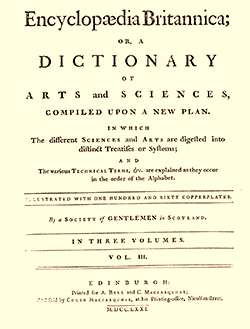 The first edition of the Encyclopedia Britannica is published.
The first edition of the Encyclopedia Britannica is published.
In Gailenreuth Cave in Germany, Father Johann Esper finds human bones underlying those of extinct animals. He concludes that the bones got there by accident, an opinion Cuvier will share.
 Italian anatomist Luigi Galvani discovers accidentally the action of electricity on the muscles of the dissected frog: it causes a twitch.
Italian anatomist Luigi Galvani discovers accidentally the action of electricity on the muscles of the dissected frog: it causes a twitch.
Joseph Priestly discovers that a plant can produce enough breathable air to sustain a mouse and keep a candle burning. Though he describes it in different terms, he has discovered oxygen.
1771
(no entry for this year)
 On June 22, Lord Chief Mansfield rules in the James Somerset case that an enslaved person brought to England becomes free and cannot be returned to slavery. His ruling establishes the legal basis for the freeing of England's fifteen thousand slaves.
On June 22, Lord Chief Mansfield rules in the James Somerset case that an enslaved person brought to England becomes free and cannot be returned to slavery. His ruling establishes the legal basis for the freeing of England's fifteen thousand slaves.
James Albert Ukawsaw Gronniosaw's writes the first autobiographical slave narrative.
New Jersey passes bill requiring a license to practice medicine.
Swedish scientist Johan Carl Wilcke calculates the latent heat of ice (the amount of heat absorbed when ice turns into water).
1772
(no entry for this year)
Jean Baptiste Point du Sable is the first settler in the community now known as Chicago. Point du Sable described himself as "a free mulatto man." He was married to a Potawatomi woman named Catherine some time in the 1770s.
 Phillis Wheatley of Boston publishes Poems on Various Subjects, Religious and Moral. This is the first book of poetry published by an African-American woman.
Phillis Wheatley of Boston publishes Poems on Various Subjects, Religious and Moral. This is the first book of poetry published by an African-American woman.
Phillis Wheatley becomes the first published African-American poet when a London publishing company releases a collection of her verse.
Slaves in Massachusetts unsuccessfully petition the government for their freedom.
The first separate black church in America is founded in South Carolina.
The "Boston Tea Party" occurs as a protest against British taxation policies.
1773
(no entry for this year)
 German poet Johann Wolfgang von Goethe writes the short novel The Sorrows of Young Werther.
German poet Johann Wolfgang von Goethe writes the short novel The Sorrows of Young Werther.
Rhode Island becomes first colony to prohibit importation of slaves.
Connecticut, Rhode Island, and Georgia prohibit the importation of slaves.
The First Continental Congress bans trade with Britain and vows to discontinue the slave trade after the 1st of December.
Virginia takes action against slave importation.
 Joseph Priestley discovers oxygen.
Joseph Priestley discovers oxygen.
1774
(no entry for this year)
Lord Dunmore, promises freedom to male slaves who join British army.
 General Washington forbids recruiting officers enlisting blacks to fight in defense of American freedom.
General Washington forbids recruiting officers enlisting blacks to fight in defense of American freedom.
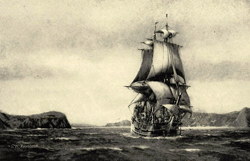 The first Spanish ship, the San Carlos, commanded by Juan Manuel de Ayala, enters San Francisco Bay.
The first Spanish ship, the San Carlos, commanded by Juan Manuel de Ayala, enters San Francisco Bay.
 The Grand Union flag is adopted by the American colonies in rebellion against England.
The Grand Union flag is adopted by the American colonies in rebellion against England.
Abolitionist Society Anthony Benezet of Philadelphia founds the world's first abolitionist society. Benjamin Franklin becomes its president in 1787.
In April, the first battles of the Revolutionary war are waged between the British and Colonial armies at Lexington and Concord, Massachusetts. Black Minutemen participate in the fighting.
In July, George Washington announces a ban on the enlistment of free blacks and slaves in the colonial army. By the end of the year, he reverses the ban, ordering the Continental Army to accept the service of free blacks.
In November, Virginia Governor John Murray, Lord Dunmore, issues a proclamation announcing that any slave fighting on the side of the British will be liberated.
The slave population in the colonies is nearly 500,000. In Virginia, the ratio of free colonists to slaves is nearly 1:1. In South Carolina it is approximately 1:2. 1775 Georgia takes action against slave importation.
Benjamin Franklin and Benjamin Rush form an anti-slavery group in Philadelphia.
The American Revolution begins with fighting at Lexington and Concord, Massachusetts.
The Continental Congress appoints George Washington head of the Continental Army.
 Franz Anton Mesmer suggests that "animal magnetism" causes attractions between certain persons. Mesmer's name becomes the root of the English verb "mesmerize".
Franz Anton Mesmer suggests that "animal magnetism" causes attractions between certain persons. Mesmer's name becomes the root of the English verb "mesmerize".
 Johann Christian Fabricius's Systema Entomologiae classifies insects based on the structure of mouth organs rather than wings.
Johann Christian Fabricius's Systema Entomologiae classifies insects based on the structure of mouth organs rather than wings.
 Alessandro Volta describes his electrofore perpetuo device for producing and storing a charge of static electricity. This device replaces the Leyden jar and eventually leads to modern electrical condensers.
Alessandro Volta describes his electrofore perpetuo device for producing and storing a charge of static electricity. This device replaces the Leyden jar and eventually leads to modern electrical condensers.
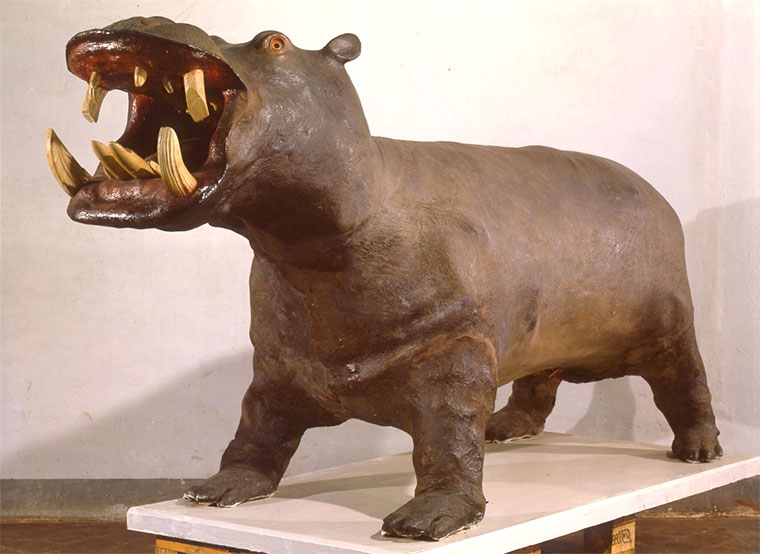 Grand duke Pietro Leopoldo establishes the Royal Museum of Physics and Natural History (La Specola) in Florence. Unlike many older natural history repositories, this institution will admit any visitor, at least anyone meeting the museum's standards for dress and hygiene. The museum includes a stuffed hippopotamus, that once belonged to Cosimo III, a member of the Medici who had a penchant for exotic animals. The hippo once roamed the Boboli Gardens. After its death, the hippo was inexpertly stuffed, and later displayed in Florence s Museum of Zoology and Natural History (La Specola), where it can still be seen today.
Grand duke Pietro Leopoldo establishes the Royal Museum of Physics and Natural History (La Specola) in Florence. Unlike many older natural history repositories, this institution will admit any visitor, at least anyone meeting the museum's standards for dress and hygiene. The museum includes a stuffed hippopotamus, that once belonged to Cosimo III, a member of the Medici who had a penchant for exotic animals. The hippo once roamed the Boboli Gardens. After its death, the hippo was inexpertly stuffed, and later displayed in Florence s Museum of Zoology and Natural History (La Specola), where it can still be seen today.
1775
(no entry for this year)
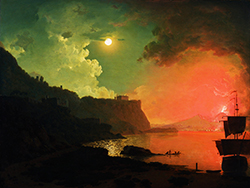 Painting by Joseph Wright: Vesuvius in Eruption is the subject of thirty paintings and at least one preliminary sketch by Joseph Wright of Derby, who travelled in Italy in the years 1773-1775. It appears that whilst Wright was in Italy Vesuvius was not erupting.
Painting by Joseph Wright: Vesuvius in Eruption is the subject of thirty paintings and at least one preliminary sketch by Joseph Wright of Derby, who travelled in Italy in the years 1773-1775. It appears that whilst Wright was in Italy Vesuvius was not erupting.
Presidio of San Francisco forms as a Spanish fort.
Continental Congress approves enlistment of free blacks .
Delaware prohibits the importation of African slaves.
In Philadelphia, Pennsylvania, members of the Continental Congress sign the Declaration of Independence.
In Philadelphia, Pennsylvania, the Society of Friends, also known as the Quakers, forbids its members from holding slaves.
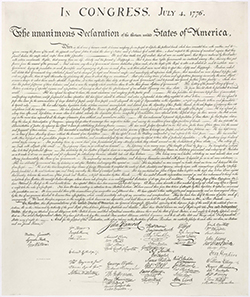 Declaration of Independence published. The Declaration of Independence is the statement adopted by the Second Continental Congress meeting at the Pennsylvania State House (Independence Hall) in Philadelphia on July 4, 1776, which announced that the thirteen American colonies, then at war with the Kingdom of Great Britain, regarded themselves as thirteen newly independent sovereign states, and no longer under British rule. Instead they formed a new nation — the United States of America. John Adams was a leader in pushing for independence, which was passed on July 2 with no opposing vote cast. A committee of five had already drafted the formal declaration, to be ready when Congress voted on independence. The term "Declaration of Independence" is not used in the document itself. Although Americans generally regard themselves as having been independent since July 4, 1776, in fact true, legal independence was not achieved until the Treaty of Paris was signed in 1783 and ratified by the Congress of the Confederation on January 14, 1784.
Declaration of Independence published. The Declaration of Independence is the statement adopted by the Second Continental Congress meeting at the Pennsylvania State House (Independence Hall) in Philadelphia on July 4, 1776, which announced that the thirteen American colonies, then at war with the Kingdom of Great Britain, regarded themselves as thirteen newly independent sovereign states, and no longer under British rule. Instead they formed a new nation — the United States of America. John Adams was a leader in pushing for independence, which was passed on July 2 with no opposing vote cast. A committee of five had already drafted the formal declaration, to be ready when Congress voted on independence. The term "Declaration of Independence" is not used in the document itself. Although Americans generally regard themselves as having been independent since July 4, 1776, in fact true, legal independence was not achieved until the Treaty of Paris was signed in 1783 and ratified by the Congress of the Confederation on January 14, 1784.
 Adam Smith publishes The Wealth of Nations, which lays the foundation for free-market capitalism.
Adam Smith publishes The Wealth of Nations, which lays the foundation for free-market capitalism.
Abbé Jacques-François Dicquemare describes reptilian fossils in Journal de Physique but refrains from speculating about their sources.
 Pierre-Simon Laplace states that if all of the forces on all objects in any one time are known, then the future can be completely predicted.
Pierre-Simon Laplace states that if all of the forces on all objects in any one time are known, then the future can be completely predicted.
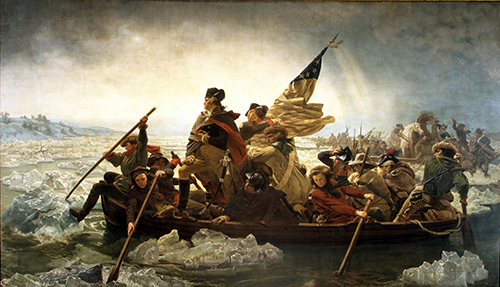 Washington leads the Continental Army in a crossing of the Delaware River, beginning on Christmas Day. The crossing catches the British army unaware, resulting in a victory for the rebel forces.
Washington leads the Continental Army in a crossing of the Delaware River, beginning on Christmas Day. The crossing catches the British army unaware, resulting in a victory for the rebel forces.
1776
(no entry for this year)
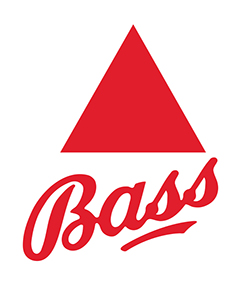 The Bass Brewery was founded in 1777 by William Bass in Burton-upon-Trent, England. The main brand was Bass Pale Ale, once the highest-selling beer in the UK. By 1877, Bass had become the largest brewery in the world, with an annual output of one million barrels. Its pale ale was exported throughout the British Empire, and the company's distinctive red triangle became the UK's first registered trademark. Bass was a pioneer in international brand marketing. Very early on, Bass applied a red triangle to casks of its Pale Ale. Bottles of Bass with the Red Triangle logo have occasionally appeared in art and literature, including Édouard Manet's 1882 painting A Bar at the Folies-Bergère. In 2001, 66,500,000 litres of Bass were sold in the United States. However Bass seems to have suffered under the custodianship of InBev and later Anheuser-Busch InBev as it is undergoing heavy decline in American consumption, with 24,200,000 litres sold in the country in 2010.
The Bass Brewery was founded in 1777 by William Bass in Burton-upon-Trent, England. The main brand was Bass Pale Ale, once the highest-selling beer in the UK. By 1877, Bass had become the largest brewery in the world, with an annual output of one million barrels. Its pale ale was exported throughout the British Empire, and the company's distinctive red triangle became the UK's first registered trademark. Bass was a pioneer in international brand marketing. Very early on, Bass applied a red triangle to casks of its Pale Ale. Bottles of Bass with the Red Triangle logo have occasionally appeared in art and literature, including Édouard Manet's 1882 painting A Bar at the Folies-Bergère. In 2001, 66,500,000 litres of Bass were sold in the United States. However Bass seems to have suffered under the custodianship of InBev and later Anheuser-Busch InBev as it is undergoing heavy decline in American consumption, with 24,200,000 litres sold in the country in 2010.
San Jose, California, is founded on orders from Antonio María de Bucareli y Ursúa, Spanish Viceroy of New Spain, thus providing an answer to the not-yet-asked question, Do you know the way to San Jose?
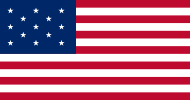 Continental Congress adopts the Stars and Stripes replacing the Grand Union flag. The new flag has thirteen stars and thirteen stripes, representing the thirteen original states: Delaware, Pennsylvania, New Jersey, Georgia, Connecticut, Massachusetts, Maryland, South Carolina, New Hampshire, Virginia, New York, North Carolina, and Rhode Island.
Continental Congress adopts the Stars and Stripes replacing the Grand Union flag. The new flag has thirteen stars and thirteen stripes, representing the thirteen original states: Delaware, Pennsylvania, New Jersey, Georgia, Connecticut, Massachusetts, Maryland, South Carolina, New Hampshire, Virginia, New York, North Carolina, and Rhode Island.
Vermont amends its constitution to ban slavery. Over the next 25 years, other Northern states emancipate their slaves and ban the institution: Pennsylvania, 1780; Massachusetts and New Hampshire, 1783; Connecticut and Rhode Island, 1784; New York, 1799; and New Jersey, 1804. Some of the state laws stipulate gradual emancipation.
New York enfranchises all free propertied men regardless of color or prior servitude.
Vermont is the first of the thirteen colonies to abolish slavery and enfranchise all adult males.
 Charles-Augustin Coulomb invents the torsion balance.
Charles-Augustin Coulomb invents the torsion balance.
1777
(no entry for this year)
The German composer Ludwig von Beethoven, age eight, is presented by his father as a music prodigy.
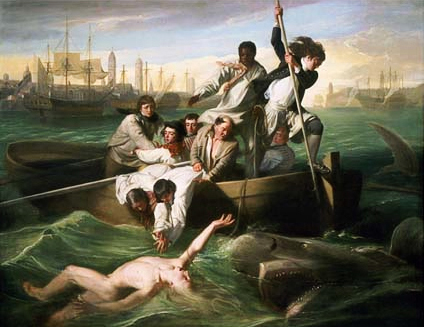 Painting by John Singleton Copley: Watson and the Shark about a shark attack on a swimmer, Brook Watson, that occurred in Havana, Cuba in 1749. Copley had never visited Havana, and it is likely that he had never seen a shark, much less a shark attack. It is probable that he gleaned details of Havana harbor from prints and book illustrations: he includes the real landmark of Morro Castle in the background of the painting. The shark is less convincing; it includes details not found in sharks, such as forward-facing eyes and lips.
Painting by John Singleton Copley: Watson and the Shark about a shark attack on a swimmer, Brook Watson, that occurred in Havana, Cuba in 1749. Copley had never visited Havana, and it is likely that he had never seen a shark, much less a shark attack. It is probable that he gleaned details of Havana harbor from prints and book illustrations: he includes the real landmark of Morro Castle in the background of the painting. The shark is less convincing; it includes details not found in sharks, such as forward-facing eyes and lips.
Rhode Island forbids the removal of slaves from the state.
Virginia prohibits the importation of slaves.
Buffon publishes Les Epoques de la Nature, asserting that the Earth is a staggering 74,832 years old, and has existed long before the arrival of humans or any other form of life.
1778
(no entry for this year)
 Jan Ingenhousz discovers two distinct respiratory cycles in plants: at night oxygen is absorbed and carbon dioxide is exhaled; during the day carbon dioxide is absorbed and oxygen is exhaled. The exact nature of the exhaled gases becomes clear with the later discoveries by Lavoisier.
Jan Ingenhousz discovers two distinct respiratory cycles in plants: at night oxygen is absorbed and carbon dioxide is exhaled; during the day carbon dioxide is absorbed and oxygen is exhaled. The exact nature of the exhaled gases becomes clear with the later discoveries by Lavoisier.
Jan Ingenhousz discovers photosynthesis: In Experiments on Vegetables Ingenhousz shows that sunlight is essential for the production of oxygen by leaves.
The first school of the arts is established in the New World, in Mexico City.
 Capt. James Cook dies during a skirmish in Hawaii.
Capt. James Cook dies during a skirmish in Hawaii.
The peculiar inheritance of human color-blindness reported to The Royal Society of London by Michael Lort.
 Lazzaro Spallanzani studies the role of semen in fertilization and learns that the sperm must make physical contact with the egg for fertilization to take place.
Lazzaro Spallanzani studies the role of semen in fertilization and learns that the sperm must make physical contact with the egg for fertilization to take place.
1779
(no entry for this year)
ESP Quick Facts
ESP Origins
In the early 1990's, Robert Robbins was a faculty member at Johns Hopkins, where he directed the informatics core of GDB — the human gene-mapping database of the international human genome project. To share papers with colleagues around the world, he set up a small paper-sharing section on his personal web page. This small project evolved into The Electronic Scholarly Publishing Project.
ESP Support
In 1995, Robbins became the VP/IT of the Fred Hutchinson Cancer Research Center in Seattle, WA. Soon after arriving in Seattle, Robbins secured funding, through the ELSI component of the US Human Genome Project, to create the original ESP.ORG web site, with the formal goal of providing free, world-wide access to the literature of classical genetics.
ESP Rationale
Although the methods of molecular biology can seem almost magical to the uninitiated, the original techniques of classical genetics are readily appreciated by one and all: cross individuals that differ in some inherited trait, collect all of the progeny, score their attributes, and propose mechanisms to explain the patterns of inheritance observed.
ESP Goal
In reading the early works of classical genetics, one is drawn, almost inexorably, into ever more complex models, until molecular explanations begin to seem both necessary and natural. At that point, the tools for understanding genome research are at hand. Assisting readers reach this point was the original goal of The Electronic Scholarly Publishing Project.
ESP Usage
Usage of the site grew rapidly and has remained high. Faculty began to use the site for their assigned readings. Other on-line publishers, ranging from The New York Times to Nature referenced ESP materials in their own publications. Nobel laureates (e.g., Joshua Lederberg) regularly used the site and even wrote to suggest changes and improvements.
ESP Content
When the site began, no journals were making their early content available in digital format. As a result, ESP was obliged to digitize classic literature before it could be made available. For many important papers — such as Mendel's original paper or the first genetic map — ESP had to produce entirely new typeset versions of the works, if they were to be available in a high-quality format.
ESP Help
Early support from the DOE component of the Human Genome Project was critically important for getting the ESP project on a firm foundation. Since that funding ended (nearly 20 years ago), the project has been operated as a purely volunteer effort. Anyone wishing to assist in these efforts should send an email to Robbins.
ESP Plans
With the development of methods for adding typeset side notes to PDF files, the ESP project now plans to add annotated versions of some classical papers to its holdings. We also plan to add new reference and pedagogical material. We have already started providing regularly updated, comprehensive bibliographies to the ESP.ORG site.
ESP Picks from Around the Web (updated 06 MAR 2017 )
Old Science

Weird Science

Treating Disease with Fecal Transplantation
Fossils of miniature humans (hobbits) discovered in Indonesia

Dinosaur tail, complete with feathers, found preserved in amber.
Astronomy

Mysterious fast radio burst (FRB) detected in the distant universe.